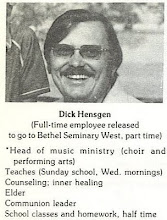This cover of this issue is a stark picture of Jesus. A song which I don't know (or remember) is written towards the bottom. It is not really very legible.
Ken Pagaard leads off the issue with his article of Covenant. He starts off by discussing the disappointments that some felt at the Charismatic Leadership Conference over people not really observing their covenant. Based upon his article in the last issue, this probably revolves around the issue of the Shepherding Movement. Ken then proceeds to discuss the idea of covenant as presented in the Old and New Testaments. His use of marriage as the best example of covenant in use today is brilliant. I have continued to use this in my ministry to the present day. He then laments that churches today don't take covenant seriously; if I am no longer happy, I will just leave. Ken states that church membership must be taken much more seriously than this.
Ken finishes his article on this page by stating that he is in for the long haul. He than asks if we are ready to join him. This sense of what belonging to the church means really colored all discussions of belonging to the church for the next several years. I still believe strongly that Ken was right in this. Yet, as the church began to fall apart in the early 80s, I spent much of my time blessing people as they left; hurt, angry, disappointed and disgusted.
Clay begins his article of First Love which will be concluded on the following page.
McFoone comes to the realization that he can cooperate with the creativity of God or the destructiveness of Satan.
Clay uses as his text Revelation 2:1,4,5 where the church is told that they have lost their first love. Clay starts by talking of how we feel when we first fall in love. He then equates this with falling in love with Jesus when we first come to know him. But, then we can become complacent and take him for granted. Clay was and is very single minded in his following Jesus. He is an evangelist and an encourager. It is no wonder that he is now the leader in our Holy Spirit Renewal Ministries. In the 70s, among other things, he was our evangelist.
After Clay finishes his article there is a small discussion about the Friday morning discipleship group. This is written by Ken. He really did enjoy working with the young men of the church.
We didn't fully know what to do with prophecy in the church. We never gave it the same authority as scripture. Therefore most were not written down. We did believe that they represented God talking to us however, so we took them seriously. I have no idea who gave this prophecy. It certainly goes along with Clay's article.
This is an illustration by Gary Bell for his poem, "Prisoner of Hope."
This is another illustration of the talents present among our young people; music, graphic and visual arts, drama, poetry and other writing.
Bud Miller writes about one of the big issues in the residential community; responsibility. Bud was one of the elders and household heads at FBCCV. I was close to him in those years, but have no knowledge of where he is now or what he is doing. I know that the millers were in Temecula for several years, but I think they returned to this area. The article itself doesn't get completely to the problem -- it stays more academic. The problem was simple -- what belonged to everyone belonged to no one. Therefore few would really take responsibility for what went on in the household. Therefore someone (the head usually) had to give orders which led to people feeling that they were treated like children. Bud also presented the other side of the coin, that we leaders needed to give authority and hold people accountable for being responsible.
Larry Clark gives some interesting perspectives on Seminary Life. Larry was a well educated man. He loves learning. He recognizes that live in the spirit can't be just academic, it must be practiced.
I suppose that Brian Gire wrote the song/poem. Brian and Pam are still married. Pam is a regular participant on comments re OLT on FB.
There are always practical issue like the kitchen that need to be addressed. One of the interesting items in the community was the participation in studies of alternate lifestyles at UCLA. There were generally favorable in their evaluations of our kids.




 f
f y
y g
g h
h g
g d
d f
f








































.jpg)